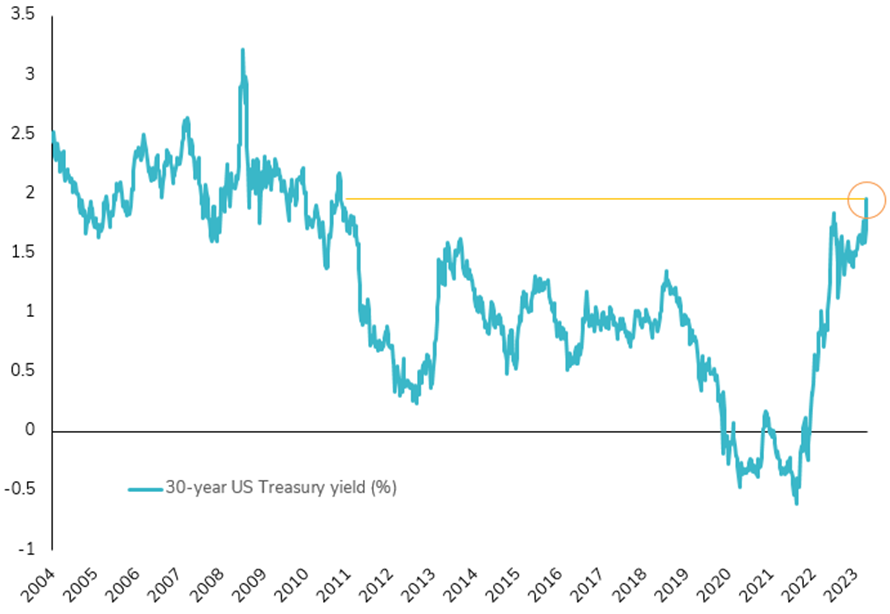What happened last week?
Central banks
During the week, there was a divide among Fed members regarding the future rate hikes. Some, like President Chicago Fed A. Gollsbee, advocated for continuing to hike rates, stating that they want to see a more definitive trend before the Fed stops raising rates. On the other hand, Federal Reserve Bank of Atlanta President R. Bostic mentioned that US employment gains are slowing in an orderly manner, and there is no need to hike rates further to ease inflation. However, it appears that the Fed is now leaning towards a soft-landing approach or aiming to avoid any recessions, as President Richmond Fed T. Barkin indicated that the easing of inflation may indicate the US economy can have a "soft landing." Following this tumultuous week in the rate market, the probability of another rate hike decreased to less than 20% by November. In Europe, the Bank of England (BoE) hiked its key rate by 25bps and changed its wording from rates "will" rise to "may” rise, which sounded like a dovish hike. Consequently, markets are not fully pricing in another hike in September, with less than an 85% chance. In Japan, Deputy Governor S. Uchida stated that the Bank of Japan (BoJ) will step into the JGB market in order to avoid any significant increase in long-term yields. The BoJ intervened twice this week to slow down the speed of yield rise.
Credit
In July, the credit market performed admirably, driven by positive excess returns resulting from tightening credit spreads. Both Investment Grade and High Yield markets saw credit spreads tighten by 10bps and 20bps, respectively, reaching their lowest levels in 18 months, resulting in gains of +0.4% and +1.4% over the month. However, the gains achieved in July were quickly reversed in just 5 trading days in August, as US Investment Grade lost 1.5% this week, and US High Yield declined by over 0.5%. These performance fluctuations were accompanied by outflows, with over $1 billion withdrawn from US High Yield funds and $1.8 billion from Investment Grade funds, according to Lipper. In Europe, July was also a solid month for credit, with gains of more than +1% in both Investment Grade and High Yield. The iTraxx Xover index hit 377bps for the first time since April 2022. Since the start of August, European rates have experienced more contained movements compared to the US, which had a lesser impact on European credit performance in the first week of August. As a result, both European Investment Grade and High Yield were almost flat this week. The best performer in July was Banking subordinated debt, supported by factors such as the reopening of the primary market (BBVA, Bank of Cyprus) and recent announcements by banks (Barclays, BBVA, Caixabank) to call their AT1 bonds at the first call. Additionally, the European bank sector has shown resilience compared to its US counterparts, as indicated by ECB Supervisory Chair, Andrea Enria. The relatively modest amount of unrealized losses on European banks' balance sheets suggests a more stable financial environment.
Rates
The U.S. Treasury curve underwent a significant steepening this week, particularly evident in the difference between the 5-year and 30-year yields, which turned positive to +4 bps from -20 bps one week ago. The long end of the yield curve experienced a substantial 40 bps jump in just two weeks, triggered by various factors such as the Treasury Department's announcement of increased auction sizes and the potential need for further supply increases in the coming quarters, alongside a repricing of a more favorable economic scenario and the BOJ's move towards monetary policy normalization, all happening in a context of relatively low liquidity (summer market + QT). Conversely, the front end of the yield curve performed well, with the 2-year US yield dropping by over 5 bps. These movements led to increased volatility, as indicated by the MOVE index hitting 125, and a positive correlation with equities resurfaced. In Europe, movements were less pronounced as inflation continued to decrease. The long end of the German yield curve rose by only 5 bps, while the front end decreased by 4 bps. The 10-year German yield ended the week slightly above 2.5%, a level similar to the start of the year. However, the difference between the 10-year US and German yields hit a year high, reaching just below 160 bps. In Japan, the 2-year Japanese yield turned positive, while the 10-year ended the week at 0.65%.
Emerging market
July was a favorable month for EM bonds, benefiting from the rebound in commodity prices and the weakening US Dollar. Local EM debts were the top performers, gaining 2.4% in July, while EM Sovereign bonds posted a solid 1.8% gain, supported by Turkish performance. However, EM corporate bonds saw a modest 0.5% gain, hindered by ongoing challenges in China's real estate sector. This week, Latin American central banks initiated easing monetary policies, with the Banco Central do Brazil surprising the market with a 50bps cut (versus an expected 25bps) and the Chilean Central Bank implementing a 100bps cut (versus an expected 50bps). However, the Colombia Central Bank decided to hold rates unchanged due to persistent inflationary pressures. On the other hand, the Central Bank of Egypt took a different approach, surprising markets with a 100bps hike to tackle surging inflation. August started with challenges as the US Treasury market experienced a meltdown, impacting all EM fixed income indexes. EM corporate bonds declined by almost 1%, and EM sovereign bonds lost over 1.5% due to their higher sensitivity to US rates. Additionally, EM local debt also fell by more than 1% amid a rebound in the US Dollar.


.png)
